 | | | Switch to: Europe, USA, New Zealand, Antarctica Credit: NOAA/Ovation  Planetary K-index Planetary K-index
Now: Kp= 1.67 quiet
24-hr max: Kp= 3.67 quiet
explanation | more data
Interplanetary Mag. Field
Btotal: 4.54 nT
Bz: -2.25 nT south
more data: ACE, DSCOVR
Updated: Today at 1145 UT  Coronal Holes: 07 Jul 25 Coronal Holes: 07 Jul 25 
There are no equatorial coronal holes on the Earthside of the sun. Credit: NASA/SDO | more data  Polar Stratospheric Clouds
Colorful Type II polar stratospheric clouds (PSC) form when the temperature in the stratosphere drops to a staggeringly low -85C. NASA's MERRA-2 climate model predicts when the air up there is cold enough: 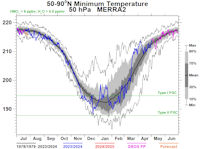
On Jul 06, 2025, the Arctic stratosphere is much too hot for polar stratospheric clouds. | more data. Noctilucent Clouds
The northern season for noctilucent clouds is underway. First reports of the electric-blue clouds came from Russia on May 28, 2025. Since then, the clouds have spread to lower latitudes, reaching Paris, France, during a major outbreak on June 23, 2025.
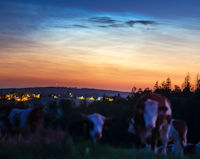
Above: July 3, 2025, in Czech Republic
"This morning, truly bright NLCs appeared over. The clouds were so bright that I could even see my shadow, and the central part was overexposed. The colors were easily visible to the naked eyes, including the red tint at the upper edge of the clouds. What a display!," says photographer Petr Horálek of Proseč u Seče, Czech Republic.
See the complete NLC Photo Gallery
 SPACE WEATHER
NOAA Forecasts | | Updated at: 2025 Jul 08 2200 UTC FLARE | 0-24 hr | 24-48 hr | CLASS M | 35 % | 35 % | CLASS X | 01 % | 01 % |  Geomagnetic Storms: Geomagnetic Storms:
Probabilities for significant disturbances in Earth's magnetic field are given for three activity levels: active, minor storm, severe storm Updated at: 2025 Jul 08 2200 UTC Mid-latitudes | 0-24 hr | 24-48 hr | ACTIVE | 10 % | 10 % | MINOR | 01 % | 01 % | SEVERE | 01 % | 01 % | High latitudes | 0-24 hr | 24-48 hr | ACTIVE | 20 % | 20 % | MINOR | 20 % | 20 % | SEVERE | 10 % | 10 % | | | |  | | | | | | | | | | | This is an AI Free Zone: AI isn't all bad. Large language models are good writers with access to vast stores of data. There's still no substitute for a human being with decades of space weather forecasting experience. This website is 100% human. | | | A LARGE HOLE IN THE SUN'S ATMOSPHERE: Straddling the sun's equator, a large hole in the sun's atmosphere is turning toward Earth. Solar wind flowing from the hole should reach our planet on July 13-14 and could spark a G1-class geomagnetic storm. Aurora alerts: SMS Text 'SPACE LIGHTNING' PHOTOGRAPHED FROM THE ISS: On July 3, 2025, astronaut Nichole Ayers aboard the International Space Station captured a rare and breathtaking image: a Gigantic Jet bursting upward from a thunderstorm in North America. The high-resolution photograph shows a crimson bolt arcing from the cloudtops toward the edge of space. 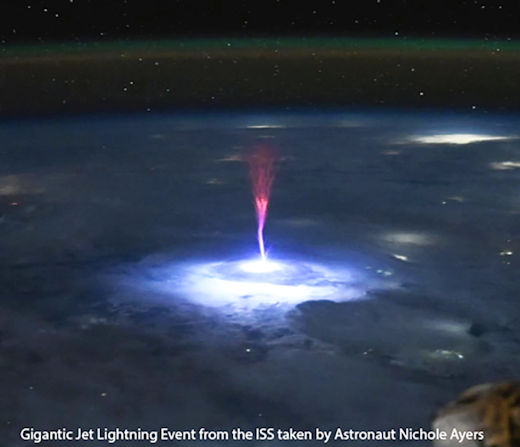
"Just. Wow," Ayers posted after the event. "As we went over Mexico and the U.S. this morning, I caught this [Gigantic Jet] triggered by intense electrical activity in the thunderstorms below." József Bór, an atmospheric scientist at the Institute of Earth Physics and Space Science in Hungary, was thrilled by the image. "Nichole's photo sets a new standard for space-borne observations of Gigantic Jets," he says. "Such a sharply focused and detailed photo of a Gigantic Jet has never been recorded from space." Most readers have heard of sprites, and maybe even seen one or two on a stormy summer night. They emerge from the tops of intense thunderstorms like upside-down lightning, reaching their eerie red tendrils toward space. 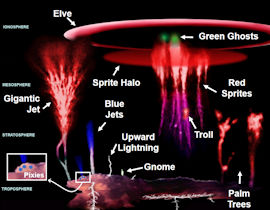 Gigantic jets like sprites on steroids--visually more impressive and far more rare. While sprites were discovered in 1989 and have since been photographed by the thousands, it was not until 2001-2002 that Gigantic Jets were first recorded from Puerto Rico and Taiwan. No more than a few dozen have ever been photographed with a quality approaching that of Ayers' image. Gigantic jets like sprites on steroids--visually more impressive and far more rare. While sprites were discovered in 1989 and have since been photographed by the thousands, it was not until 2001-2002 that Gigantic Jets were first recorded from Puerto Rico and Taiwan. No more than a few dozen have ever been photographed with a quality approaching that of Ayers' image.
Bór is currently running a project called UHU, which alerts astronauts aboard the ISS to thunderstorms that might produce Gigantic Jets and other Transient Luminous Events (TLEs). The goal is to coordinate space-based observations with ground-based instruments to triangulate and study these elusive phenomena. Photographers from around the world are invited to contribute.
Ironically, Ayers wasn't acting on a UHU alert. She caught this Gigantic Jet by chance. Still, Bór remains hopeful: "A simultaneous observation would allow us to calculate the exact location, altitude, and dimensions of the jet, and examine the position of the initiation point relative to weather radar data. Hungarian astronaut Tibor Kapu is onboard the ISS now as part of the Ax-4 mission, and will be working with Bór to make that happen.
Ayers's photo is now one of the best ever taken of a Gigantic Jet—and a promising sign of what coordinated space-Earth campaigns could uncover next. Realtime Space Weather Photo Gallery
Free: Spaceweather.com Newsletter "ALWAYS AND FOREVER" RUBY HEART PENDANT: Are you looking for a far out gift? Consider the Always and Forever Space Pendent. The students of Earth to Sky Calculus launched it to the stratosphere onboard a cosmic ray research balloon: 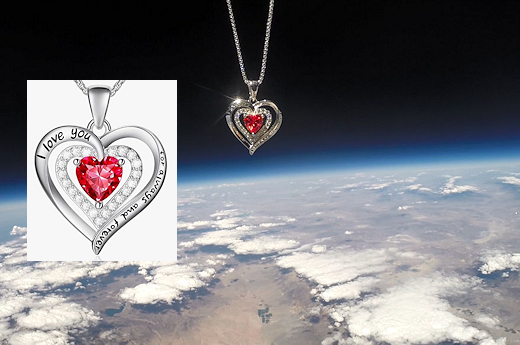
You can have it for $219.95. Engraved with the words "I love you always and forever", this sterling silver pendant has a heart-shaped ruby crystal in the middle surrouunded by a ring of glittering 5A cubic zirconia nuggets. It is a visually striking necklace perfect for Valentine's Day, anniversaries, or romantic birthdays. The students are selling space pendants to pay the helium bill for their cosmic ray ballooning program. Each one comes with a greeting card showing the jewelry in flight and telling the story of its trip to the stratosphere and back again. Far Out Gifts: Earth to Sky Store
All sales support hands-on STEM education
Realtime Aurora Photo Gallery
Free: Spaceweather.com Newsletter
Realtime Noctilucent Cloud Photo Gallery
Free: Spaceweather.com Newsletter Every night, a network of NASA all-sky cameras scans the skies above the United States for meteoritic fireballs. Automated software maintained by NASA's Meteoroid Environment Office calculates their orbits, velocity, penetration depth in Earth's atmosphere and many other characteristics. Daily results are presented here on Spaceweather.com. On Jul 04, 2025, the network reported 7 fireballs.
(7 sporadics) 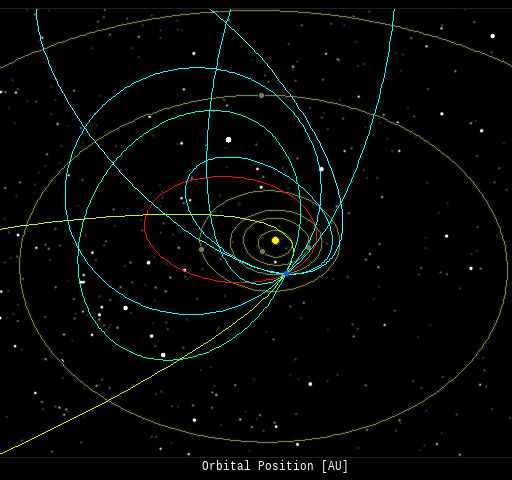 In this diagram of the inner solar system, all of the fireball orbits intersect at a single point--Earth. The orbits are color-coded by velocity, from slow (red) to fast (blue). [Larger image] [movies] Potentially Hazardous Asteroids ( PHAs) are space rocks larger than approximately 100m that can come closer to Earth than 0.05 AU. None of the known PHAs is on a collision course with our planet, although astronomers are finding new ones all the time. On July 8, 2025 there were 2349 potentially hazardous asteroids.
 | Recent & Upcoming Earth-asteroid encounters: | Asteroid | Date(UT) | Miss Distance | Velocity (km/s) | Diameter (m) | | 2025 MK90 | 2025-Jul-02 | 13.8 LD | 9.4 | 30 | | 2025 NC | 2025-Jul-02 | 1.6 LD | 8.8 | 11 | | 2025 MY88 | 2025-Jul-04 | 8.8 LD | 8.5 | 37 | | 2025 MV89 | 2025-Jul-04 | 5.1 LD | 8.7 | 39 | | 2025 MW91 | 2025-Jul-05 | 16 LD | 16.6 | 45 | | 2025 MN88 | 2025-Jul-06 | 1.9 LD | 7.8 | 21 | | 2025 NJ | 2025-Jul-07 | 9.4 LD | 13.5 | 26 | | 2025 MO | 2025-Jul-07 | 6.7 LD | 4.6 | 10 | | 2025 MC92 | 2025-Jul-08 | 4 LD | 5 | 9 | | 2019 JM | 2025-Jul-09 | 16.6 LD | 6.9 | 14 | | 2019 NW5 | 2025-Jul-09 | 15.2 LD | 16.5 | 65 | | 2025 MH90 | 2025-Jul-10 | 19.4 LD | 6.5 | 53 | | 2025 MD89 | 2025-Jul-11 | 14.7 LD | 8.1 | 38 | | 2005 VO5 | 2025-Jul-11 | 15.9 LD | 14.4 | 397 | | 2025 MD1 | 2025-Jul-11 | 18 LD | 8.9 | 44 | | 2025 MG1 | 2025-Jul-12 | 13.2 LD | 7.2 | 41 | | 2025 MA90 | 2025-Jul-15 | 16.9 LD | 9.1 | 89 | | 2022 YS5 | 2025-Jul-17 | 17.4 LD | 6.1 | 38 | | 2018 BY6 | 2025-Jul-19 | 13.7 LD | 7.4 | 68 | | 2025 ME92 | 2025-Jul-20 | 13.4 LD | 5.3 | 31 | | 2019 CO1 | 2025-Aug-08 | 17.8 LD | 10.5 | 65 | | 2022 QB1 | 2025-Aug-10 | 8.9 LD | 3.9 | 6 | | 2021 PJ1 | 2025-Aug-15 | 4.4 LD | 9.3 | 24 | | 2025 CO3 | 2025-Aug-16 | 19.8 LD | 8.4 | 90 | | 1997 QK1 | 2025-Aug-20 | 7.9 LD | 9.8 | 315 | | 2022 QD3 | 2025-Aug-21 | 15 LD | 6.9 | 35 | | 2023 PX | 2025-Aug-22 | 2.4 LD | 8.3 | 23 | | 2019 QQ6 | 2025-Aug-24 | 9.4 LD | 17.2 | 31 | | 2017 RK15 | 2025-Aug-29 | 15.8 LD | 13.2 | 26 | | 2020 TS1 | 2025-Aug-29 | 17.8 LD | 3.3 | 5 | | 1998 SH2 | 2025-Aug-30 | 8.1 LD | 17.3 | 246 | Notes: LD means "Lunar Distance." 1 LD = 384,401 km, the distance between Earth and the Moon. 1 LD also equals 0.00256 AU. | | Cosmic Rays in the Atmosphere | SPACE WEATHER BALLOON DATA: Almost once a week, Spaceweather.com and the students of Earth to Sky Calculus fly space weather balloons to the stratosphere over California. These balloons are equipped with sensors that detect secondary cosmic rays, a form of radiation from space that can penetrate all the way down to Earth's surface. Our monitoring program has been underway without interruption for 10 years, resulting in a unique dataset of in situ atmospheric measurements. Latest results (Nov. 2024): Atmospheric radiation is sharply decreasing in 2024. Our latest measurements in November registered a 10-year low: 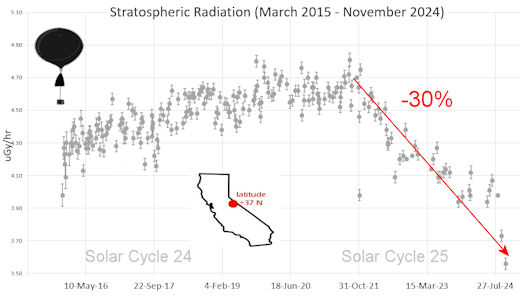
What's going on? Ironically, the radiation drop is caused by increasing solar activity. Solar Cycle 25 has roared to life faster than forecasters expected. The sun's strengthening and increasingly tangled magnetic field repels cosmic rays from deep space. In addition, solar coronal mass ejections (CMEs) sweep aside cosmic rays, causing sharp reductions called "Forbush Decreases." The two effects blend together to bring daily radiation levels down. .Who cares? Cosmic rays are a surprisingly "down to Earth" form of space weather. They can alter the chemistry of the atmosphere, trigger lightning, and penetrate commercial airplanes. According to a study from the Harvard T.H. Chan school of public health, crews of aircraft have higher rates of cancer than the general population. The researchers listed cosmic rays, irregular sleep habits, and chemical contaminants as leading risk factors. A number of controversial studies (#1, #2, #3, #4) go even further, linking cosmic rays with cardiac arrhythmias and sudden cardiac death. Technical notes: The radiation sensors onboard our helium balloons detect X-rays and gamma-rays in the energy range 10 keV to 20 MeV. These energies span the range of medical X-ray machines and airport security scanners. Data points in the graph labeled "Stratospheric Radiation" correspond to the peak of the Regener-Pfotzer maximum, which lies about 67,000 feet above central California. When cosmic rays crash into Earth's atmosphere, they produce a spray of secondary particles that is most intense at the entrance to the stratosphere. Physicists Eric Regener and Georg Pfotzer discovered the maximum using balloons in the 1930s and it is what we are measuring today. | | The official U.S. government space weather bureau | | | The first place to look for information about sundogs, pillars, rainbows and related phenomena. | | | Researchers call it a "Hubble for the sun." SDO is the most advanced solar observatory ever. | | | 3D views of the sun from NASA's Solar and Terrestrial Relations Observatory | | | Realtime and archival images of the Sun from SOHO. | | | information about sunspots based on the latest NOAA/USAF Active Region Summary | | | current counts of failed and deployed Starlink satellites from Jonathan's Space Page. See also, all satellite statistics. | | | Authoritative predictions of space junk and satellite re-entries | | | from the NOAA Space Environment Center | | | fun to read, but should be taken with a grain of salt! Forecasts looking ahead more than a few days are often wrong. | | | from the NOAA Space Environment Center | | | the underlying science of space weather |  | Got a chipped or cracked windshield that prevents you from seeing space weather events while driving? Get windshield replacement from SR Windows & Glass with free mobile auto glass service anywhere in the Phoenix area. |  | BestCSGOGambling is the best site for everything related to CSGO gambling on the web | | | These links help Spaceweather.com stay online. Thank you to our supporters! | | | | | | | | |  | |  |   | ©2021 Spaceweather.com. All rights reserved. This site is penned daily by Dr. Tony Phillips. | |

